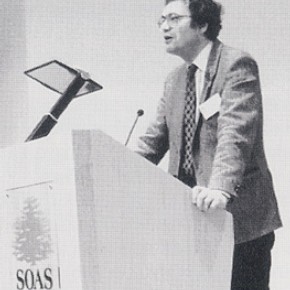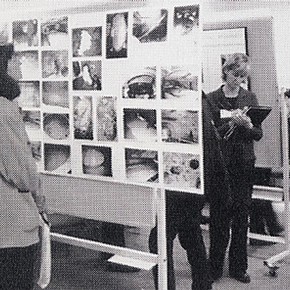Conservation Journal
January 1996 Issue 18
Review: Lining and Backing - The Support of Paintings, Paper and Textiles
UKIC Conference, London
7-8 November 1995
It is now more than 20 years since the Greenwich Lining Conference, which had such an enormous impact on approaches to lining in paintings conservation. Since that time, research into conservation issues has deepened and accelerated, conservators are more confident about questioning accepted methods and an ongoing process of evaluation and re-assessment is an accepted part of conservation practice.
Current issues surrounding the support of paintings, paper and textiles continue to be the subject of debate and discussion. In his perceptive and witty introduction to the UKIC Lining and Backing conference, Jonathan Ashley-Smith drew our attention to the factors which concern conservators from all three disciplines when considering a lining option. These include questions of moisture content, tension and rigidity and the difficulty of predicting the effect of providing a laminated structure to a complex layered and degraded structure as well as the ethical problem of deciding when it is appropriate to make the intervention. His advice to conference delegates was first to 'choose a technique that does something more than just support: it must also slow down the rate of decay' and secondly, 'choose a support material that is far more durable than the object'.
The concept of cross-disciplinary meetings has developed in recent years. It started with 'Paper and Textiles - The Common Ground' held in 1990 by the Scottish Society for Conservation and Restoration (SSCR) at the Burrell Collection and continued more recently at the British Museum with the conference 'Restoration - Is It Acceptable?' in addition to smaller meetings such as the UKIC Textile Group's Starch Forum held in 1994 at the Museum of London. Lining and Backing offered an opportunity to review recent advances in thinking and for conservators to benefit from the expertise of their colleagues in related fields.
Eighteen papers and sixteen posters were presented in the two day conference which was held at the Brunei Gallery at the University of London's School for Oriental and African Studies (SOAS). Nearly 300 delegates attended and many more wanted to attend. All seats were sold well in advance to delegates from 18 countries and such was the demand for tickets that the organisers briefly considered changing the venue to a larger hall two weeks before the conference. Predictably there was a slightly higher proportion of papers and posters from paintings conservators than from paper and textile conservators and this ratio was also reflected in the audience. The conference began with an overview of each specialism. The development of lining and backing within each of the three fields was described and major issues in current practice were explored. Each paper was meticulously referenced and the aim was not only to provide an introduction to the rest of the conference but also to establish solid, up-to-date reference material for students. The papers which followed were generally of a very high standard but only a few directly crossed the boundaries between the disciplines. Of these, Vincent Daniels' paper on the reversibility of starch paste was a valuable and much needed contribution (Fig. 1). His results provided theoretical support to the experience of both paper and textile conservators who find it difficult to remove final traces of starch from the back of an object without using the enzyme amylase.
The larger proportion of the papers were practically based. Conservators from all disciplines commented on the paper 'Architectural Linings and Backings' (Mark Sandiford and Sherry Doyal). The presentation was lucid and genuine. Sandiford's observations on the behaviour of historical linen or jute linings for wallpaper and textile wall coverings and his preference for inert polyester lining materials opened up the debate about whether to use natural or synthetic supports. Sandiford also emphasised the importance of good craftsmanship. Karoline Beltinger's paper was well received by both textile and paper conservators who saw direct application in their own fields of an alternative to lining. Other papers were memorable because of the technical skill developed to overcome complex conservation problems. Vivian Lochhead had developed very specialized techniques for the conservation of trade union banners. This paper, concerned solely with painted textiles, highlighted the traditional difference in approach between textile conservators and paintings conservators: 'a textile with painted decoration or a painting or a textile substrate'. Alan Phenix, in his overview on paintings conservation, described the change in attitude from the perception of the painting as an image to that of seeing the painting as an object.
There were few papers which really explored the mechanics of what happens in the lining process. Mary Ballard examined differences in the stress-strain behaviour of a variety of fibres and how these qualities affect the choice of support fabrics. Paul Ackroyd gave an excellent account of work carried out at the National Gallery on the mechanics of traditional glue linings and was able to provide theoretical insight into methods which have been used historically in paintings conservation and developed experientially over many years.
Many conservators commented on how they had gained new perspectives from listening to papers on related disciplines. It was interesting to hear, for example, how developments in lining techniques in paintings conservation have influenced those in textile conservation. Michel Scharff gave a clear and detailed description of the thought processes behind developments in lining techniques in Denmark which are leading to a greater range of treatment options. His series of slides of the lamination process bore an uncanny resemblance to a textile treatment.
Was the conference a success? Most conservators agreed that they learnt something new about their own disciplines and certainly something new about the other two disciplines. Many commented on the maturity of the experience represented in the papers; others said that, in a year of too many conferences, this was a focused and stimulating event and that the combination of disciplines generated a dynamic and energetic atmosphere.
There were inevitable disappointments. The discussion at the end of the two days never really got off the ground despite Jonathan Ashley-Smith's excellent summing up. The venue was unintimidating but perhaps the group was too large to generate spontaneous debate. There were complaints that some of the papers were read, and disappointment that the venue did not provide enough facility for conservators to meet outside the conference hall and discuss things among themselves. There were many outstanding posters representing a lot of work. Unfortunately, however, there was not enough time to appreciate them fully (Fig. 2). There was no room for a trade fair but the demonstration of a low vacuum suction table had obvious relevance for each of the disciplines. The bookstall was a great success and there were popular visits to conservation studios in major institutions scheduled after the conference. There was also a lavish reception at the Courtauld Institute of Art generously hosted by John Murdoch. All of this was organised by UKIC in little more than a year - an achievement in itself.
Despite the fact that no really new work on lining was presented, conservators were able to take a new look at the problems of lining and backing by seeing how this important issue is approached in other disciplines. Both painting and paper conservation techniques have direct relevance to textile conservation and I believe that textile conservators found this conference very beneficial.
I would like to thank Stephen Hackney, Paintings Conservation, Tate Gallery, Alison Lister of the Textile Conservation Centre and Penny Jenkins, paper conservator in private practice. Thanks are also due to Andrew Thompson of Eastern Pictorial Art Conservation, British Museum for his help and permission to publish the photographs.
January 1996 Issue 18
- Editorial
- The Examination and Conservation of the Raphael Cartoons: an interim report
- Tarnishing of Silver: A Short Review
- The Xmas Cake Dress
- Review: Lining and Backing - The Support of Paintings, Paper and Textiles
- Student Summer Placements
- Summer Placement at the Canadian Museum of Civilisation
- Summer Placement at the Asian Art Museum of San Francisco
- Summer Placement at the Metropolitan Museum of Art

